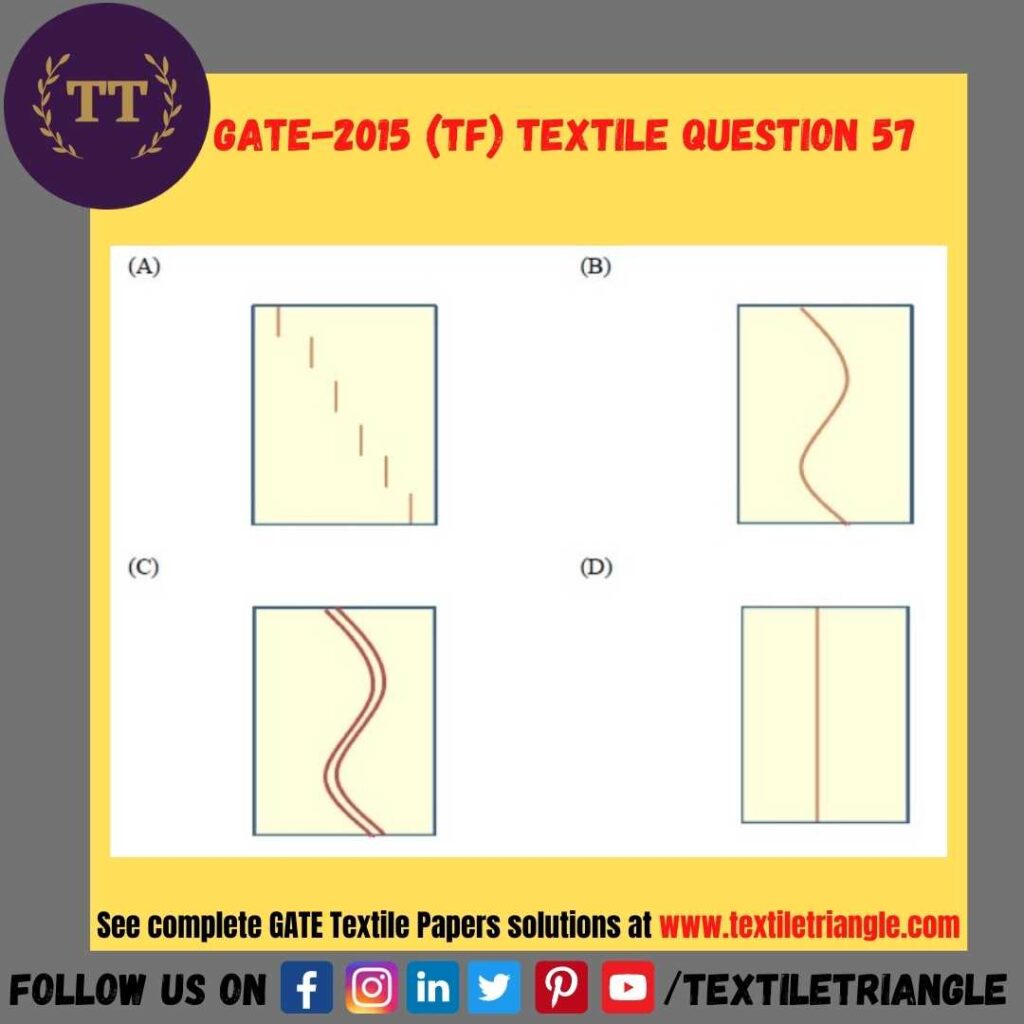Question 57 (Textile Engineering & Fibre Science)
A small hard particle is stuck in the doctor blade of a roller printing machine. The printing fault on the fabric, as a result of this, is represented by the figure

[Show Answer]
Write Here
C
Frequently Asked Questions | FAQs
What is roller printing used for?
Roller printing, also known as calender printing or machine printing, is a method of textile printing that involves the use of engraved rollers to apply a design or pattern onto fabric. It is a popular method for large-scale production of printed textiles.
In roller printing, the fabric is passed through a series of rollers, each of which has a different section of the design engraved on its surface. The engraved sections of the rollers are coated with dye or pigment, and as the fabric passes through the rollers, the dye or pigment is transferred onto the fabric, creating the desired pattern or design.
The process of roller printing typically involves several steps, including:
Engraving: The design or pattern is engraved onto the surface of the rollers using various techniques such as laser engraving or chemical etching. Each roller is engraved with a specific section of the design.
Color preparation: Dye or pigment is prepared in the desired colors and consistency, and is applied to the engraved sections of the rollers.
Printing: The fabric is passed through the rollers, which rotate and transfer the dye or pigment onto the fabric. The pressure, speed, and tension of the fabric can be adjusted to control the amount of dye or pigment transferred and the sharpness of the design.
Drying and fixing: After printing, the fabric is usually dried and then subjected to a fixing process, such as heat setting or steaming, to ensure that the dye or pigment bonds with the fabric fibers and becomes colorfast.
Washing and finishing: The printed fabric may be washed to remove any excess dye or pigment, and then finished through processes such as washing, drying, and ironing to give it the desired appearance, texture, and hand feel.
Roller printing allows for precise and efficient application of designs onto fabric, making it suitable for high-volume production of textiles with repetitive patterns or designs. It is widely used in the textile industry for various applications, including fashion fabrics, home textiles, and upholstery fabrics.
What is a doctor blade in printing?
In roller printing, a doctor blade is a critical component of the printing process. It is a thin, flexible blade made of materials such as stainless steel or plastic that is used to remove excess dye or pigment from the surface of the engraved roller, ensuring that only the engraved portions of the roller are filled with dye or pigment and transferred onto the fabric during printing.
The doctor blade is positioned against the surface of the engraved roller, usually at a slight angle, and it scrapes across the surface of the roller as it rotates. The blade effectively wipes off the excess dye or pigment from the non-engraved areas of the roller, leaving only the engraved sections filled with dye or pigment. This ensures that the dye or pigment is applied only to the desired areas of the fabric, creating the intended design or pattern.
The doctor blade is carefully adjusted to control the amount of dye or pigment that is wiped off from the roller. Factors such as blade angle, pressure, and position can affect the amount of dye or pigment transferred to the fabric, as well as the sharpness and clarity of the printed design. Proper adjustment of the doctor blade is crucial to achieving consistent and high-quality results in roller printing.
In addition to removing excess dye or pigment, the doctor blade can also help to prevent clogging of the engraved roller, ensure uniform application of dye or pigment, and extend the life of the roller by minimizing wear and tear. It is an essential tool in the roller printing process and plays a critical role in achieving precise and efficient textile printing results.
